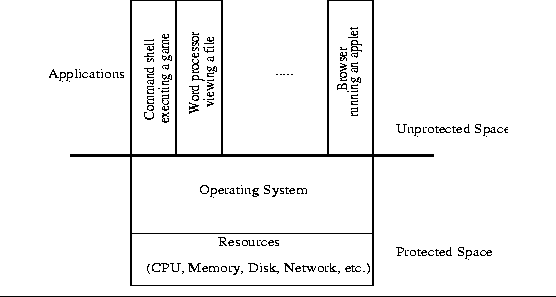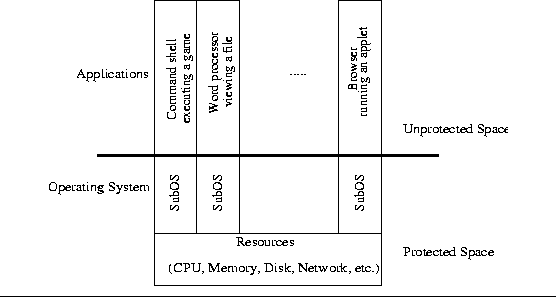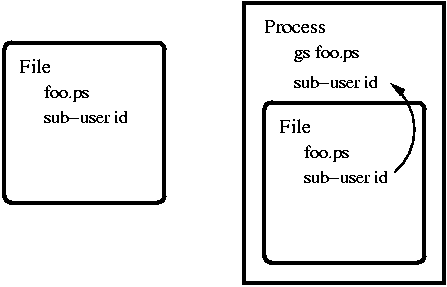 |

![[*]](../../../graphics/buttons/cross_ref_motif.gif) and
and ![[*]](../../../graphics/buttons/cross_ref_motif.gif) demonstrate the difference between
a regular and a SubOS-enabled operating system.
The access rights for that object are determined by a sub-user id that is
assigned to it when it is first accepted by the system.
The sub-user id is a similar notion to the regular UNIX user id's.
In UNIX the user id determines what resources the user is allowed to have access to, in SubOS the sub-user id determines what resources the object
is allowed to have access to.
The advantage of using sub-user id's is that we can identify individual
objects with an immutable tag, which allows us to bind a set of access rights
to them. This allows for finer grain per-object access control, as opposed to
per-user access control.
demonstrate the difference between
a regular and a SubOS-enabled operating system.
The access rights for that object are determined by a sub-user id that is
assigned to it when it is first accepted by the system.
The sub-user id is a similar notion to the regular UNIX user id's.
In UNIX the user id determines what resources the user is allowed to have access to, in SubOS the sub-user id determines what resources the object
is allowed to have access to.
The advantage of using sub-user id's is that we can identify individual
objects with an immutable tag, which allows us to bind a set of access rights
to them. This allows for finer grain per-object access control, as opposed to
per-user access control.
 |
 |
The idea becomes clear if we look at the example shown in Figure
![[*]](../../../graphics/buttons/cross_ref_motif.gif) . Let us assume that our untrusted object is a postscript
file foo.ps. To that object we have associated a sub-user id, as we will
discuss in Section
. Let us assume that our untrusted object is a postscript
file foo.ps. To that object we have associated a sub-user id, as we will
discuss in Section ![[*]](../../../graphics/buttons/cross_ref_motif.gif) . Foo.ps initially is an inactive object
in the file system. While it remains inactive it poses no threat to the
security of the system. However the moment gs(1) opens it, and
starts executing its code, foo.ps becomes active, and automatically a possible
danger to the system. To contain this threat, the applications that open
untrusted objects, inherit the sub-user id of that objects, and are hereafter
bound to the permissions and privileges dictated by that sub-user id.
. Foo.ps initially is an inactive object
in the file system. While it remains inactive it poses no threat to the
security of the system. However the moment gs(1) opens it, and
starts executing its code, foo.ps becomes active, and automatically a possible
danger to the system. To contain this threat, the applications that open
untrusted objects, inherit the sub-user id of that objects, and are hereafter
bound to the permissions and privileges dictated by that sub-user id.
There is a strong analogy here to the standard UNIX setuid(2) mechanism. When a suitably-marked file is executed, the process acquires the access rights of the owner. With SubOS, suitably-marked processes acquire the access rights of the owner of the files that they open. In this case, of course, the new rights are never greater than those the process had before.
 |
The advantages of our approach become apparent if we consider the alternative methods of ensuring that a malicious object does not harm the system. Again using our postscript example we can execute foo.ps inside a safe interpreter that will limit its access to the underlying file system. There are however a number of examples on how relying on safe languages fails [11]. We could execute the postscript interpreter inside a sandbox using chroot(2), but this will prohibit it from accessing font files that it might need. Finally we could read the postscript code and make sure that it does not include any malicious commands, but this is impractical.
Our method provides transparency to the user and increased security since every data object has its access rights bound to its identity, preventing it from harming the system.